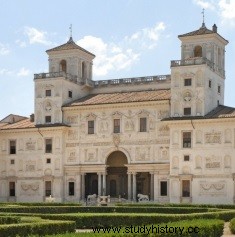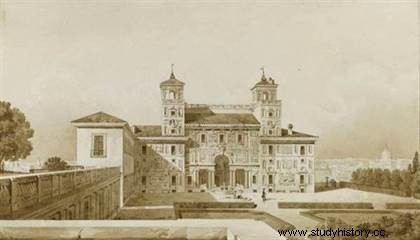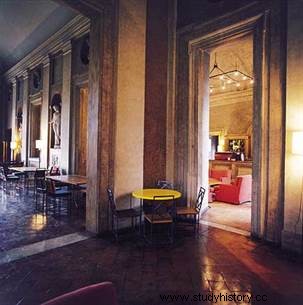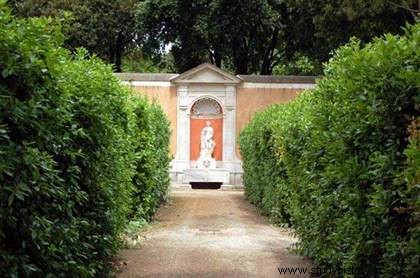 Palace built in the 16th century in Rome, the Villa Medici has housed the prestigious French Academy in Rome since 1803 . The latter was founded in 1666 at the instigation of Colbert, Le Brun and Le Bernin, in order to train French artists in the study of Antiquity. Being a resident there opens many doors for all artists and researchers in the field of literary and artistic creation. Let's go back to the history of this essential institution, this temple of French culture which is open to the public by offering various exhibitions and visits to the gardens.
Palace built in the 16th century in Rome, the Villa Medici has housed the prestigious French Academy in Rome since 1803 . The latter was founded in 1666 at the instigation of Colbert, Le Brun and Le Bernin, in order to train French artists in the study of Antiquity. Being a resident there opens many doors for all artists and researchers in the field of literary and artistic creation. Let's go back to the history of this essential institution, this temple of French culture which is open to the public by offering various exhibitions and visits to the gardens.
Villa Medici in Rome
In antiquity, the location of the Villa Medici was on a hill in Rome, north of the Quirinal, on the site of Pincio. During the Renaissance, Cardinal Ricci bought the estate in 1564, discovered the Aurelian wall and the gardens and had a palace built there. Ferdinando de' Medici bought the whole thing twelve years later and undertook to complete the work. He transformed the palace into a museum by creating a gallery-antiquarium, gardens with rare species, built a pavilion called the studiolo consisting of a main room and a smaller one opening onto a terrace overlooking the countryside. This is how the Villa Medici was born.
 The villa is composed of a central volume surmounted by a roof terrace and flanked by two side bodies slightly highlights, each enhanced by a belvedere tower. The facade which overlooks Rome is massive and severe, however embellished in its front with a porphyry basin by Annibale Lippi (a fountain which subsequently inspired many painters, including Corot, and became an almost emblematic ornament of the villa ), while the facade overlooking the garden was designed as a huge theater set. The walls of the central body and the two avant-corps are almost blind and pierced with rare openings. They are richly decorated with frames and niches that house embedded bas-reliefs, statues, busts, theatrical masks and garlands, some of which date back to antiquity and come from the Ara Pacis.
The villa is composed of a central volume surmounted by a roof terrace and flanked by two side bodies slightly highlights, each enhanced by a belvedere tower. The facade which overlooks Rome is massive and severe, however embellished in its front with a porphyry basin by Annibale Lippi (a fountain which subsequently inspired many painters, including Corot, and became an almost emblematic ornament of the villa ), while the facade overlooking the garden was designed as a huge theater set. The walls of the central body and the two avant-corps are almost blind and pierced with rare openings. They are richly decorated with frames and niches that house embedded bas-reliefs, statues, busts, theatrical masks and garlands, some of which date back to antiquity and come from the Ara Pacis.
A loggia formed by columns of cipolin and Egyptian granite digs this facade into a vast and high Serlian:it is framed on either side by two marble lions and surmounted by the coat of arms of the Medici. It provides access by a double staircase to the gardens planted with cypresses and umbrella pines (planted at the instigation of the painter Dominique Ingres, at the time of his directorship at the Villa Medici), gardens over which it offers an enchanting view .
The Académie de France is looking for a palace
In 1666, Colbert and Le Brun pushed Louis XIV to found an Academy of France in Rome, Italy being almost the cradle of art. There, the best artists as well as those protected by the great lords could acquire additional training. These young boarders had to devote their time to making copies of the Antique or the Renaissance.
During the hundred years preceding the Revolution, the Academy will change palaces:from that of San Onofrio to the Cafarelli palace in 1673, then to the Capranica palace in 1684 and finally the Mancini palace in 1725 until 1793 when the Roman counter-revolutionaries sacked and plundered the premises, the boarders having to flee to Naples and Florence:the Académie de France was then suppressed. The Directory reestablished this institution in 1795, but it was not until 1803 that the Académie de France definitively found its palace of the arts in Rome:the Villa Medici.
During the Second World War, the Villa was requisitioned by Mussolini and the Academy was transferred to Nice and then Fontainebleau.
The principle and missions of the Académie de France
Initially, the Académie de France in Rome, which is attached to the Institut de France, welcomed residents keen on painting, sculpture, architecture and music. Very great French artists and architects stayed in Rome, such as Fragonard, Ingres who was director from 1835 to 1841, Berlioz, Bizet, Debussy, Gounod, Garnier…until women entered the 20th century. In 1961, the painter Balthus was appointed director by André Malraux. He undertook a reform and a restoration in the Renaissance spirit with molding of statues in the gardens, discovery of frescoes painted at the time of Cardinal Ricci as well as a decoration representing a pergola populated by a multitude of birds, creation of exhibition halls in order to open the Villa to culture. It will also develop cultural events.
 From 1971, the Academy broke away from the supervision of the Academy of Fine Arts and the organization of competitions is modified; the duration of stays is reduced from four years to two years; new cultural fields are emerging:musical composition, writing, cinema, photography, staging, choreography, scenography, design, engraving, restoration of works of art or monuments, art history and art history ( music, theatre, cinema). This is how the residents go from twelve to twenty-two, not only from Europe but from all over the world.
From 1971, the Academy broke away from the supervision of the Academy of Fine Arts and the organization of competitions is modified; the duration of stays is reduced from four years to two years; new cultural fields are emerging:musical composition, writing, cinema, photography, staging, choreography, scenography, design, engraving, restoration of works of art or monuments, art history and art history ( music, theatre, cinema). This is how the residents go from twelve to twenty-two, not only from Europe but from all over the world.
The statutes date from 1971 with a board of directors and its director appointed by the President of the French Republic for a period of three years under the supervision of the Ministry of Cultural Affairs, institution with financial autonomy. Its mission is to promote artistic and literary creation for the period from the Renaissance to the present day; organize exhibitions, concerts, cinema screenings, history and art seminars; to welcome artists and researchers to improve their skills in their discipline; to stimulate culture between Italy and France but with an opening on Europe and the World; and above all to preserve, restore and enhance the Villa Medici, including its gardens, outbuildings and cultural assets found there... but there would be talk of an overhaul of these statutes.
The restoration of the Villa Medici
 The Villa Medici plays a big role in the cultural life of Rome, with exhibitions, concerts, seminars relating to the arts, letters and their history. But the Villa needs to be restored. Since 1993, the Ministry of Culture, the Department of Heritage and Architecture, the Fondation Electricité de France and the Italian services have endeavored to restore the Villa Medici to its late 16th century splendor by restoring "the closed and covered” of the Villa (facades, joinery, roofs, interior of the Villa where significant cracks are discovered).
The Villa Medici plays a big role in the cultural life of Rome, with exhibitions, concerts, seminars relating to the arts, letters and their history. But the Villa needs to be restored. Since 1993, the Ministry of Culture, the Department of Heritage and Architecture, the Fondation Electricité de France and the Italian services have endeavored to restore the Villa Medici to its late 16th century splendor by restoring "the closed and covered” of the Villa (facades, joinery, roofs, interior of the Villa where significant cracks are discovered).
In 2000, the original ivory white color of the facades of the Villa was rediscovered, in harmony with the ancient marbles; since 2004, there have been consolidation works on the building and the refurbishment of the exhibition halls accompanied by lighting. But alongside the Renaissance period, we must also think of the restoration of the time when Balthus was director, a great artist by the way.
Over the past few years, restoration has focused on Renaissance-style gardens, with those intended for the cultivation of single plants and flowers and those concerned with the cultivation of rare plants and medicinal, but always reminiscent of the personality of Ferdinando de Medici, passionate about geometry, mathematics and cartography, such as the current work on the alignment of hedges, which will make it possible to rediscover the squared aspect of the Renaissance. Let's not forget the fountain "le Parnasse" which is again of the most beautiful effect.
The opinion of the "residents"
 Paradise for some, golden prison for others, the Villa Medici is considered by some as a refuge for artists most often applying for the scholarship.
Paradise for some, golden prison for others, the Villa Medici is considered by some as a refuge for artists most often applying for the scholarship.
A former boarder said a few years ago "if you come to the Villa with the myths of the 19th century in mind, you are bound to be disappointed:here, you have the luxury of time, the magic of the place, but as soon as you leave the Villa, reality jumps out at you”; a writer added "I know that I will never again meet such working conditions, installed in the former workshop of Ingres, with a breathtaking view of Rome.
In this place from another era, out of the world and out of reality, full of ghosts, you have to work, otherwise you'll go crazy" as was the case for Debussy who wanted to leave the place, because in a vacuum, some residents feel guilty, crushed by this prestigious place or, conversely, afraid of coming back to reality when they go out, use all the stratagems to prolong their stay!
All is not negative, however, and most of the former residents draw up a positive assessment of their time at the Villa Medici, this place of memory where the "Gounod, Fragonard , Debussy and so many others”... In addition to concerts, conferences or seminars, the Villa Médicis regularly organizes retrospectives dedicated to great French painters such as Corot, Courbet, Jacques Louis David, Ingres, Gustave Moreau or Poussin.
To go further
- Villas and Palaces of Rome. Victory Square, 2015.
- Monumental. The Villa Medici, restorations 1991-1997 - number 19, December 1997.
- The French Academy in Rome in the 19th and 20th centuries. :Between tradition, modernity and creation.
